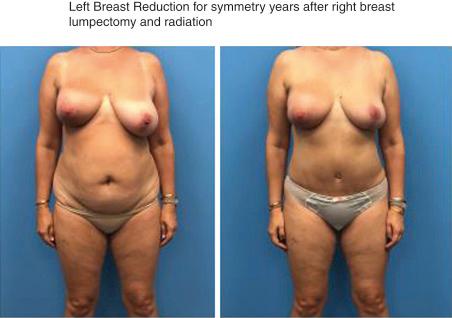Physical Address
304 North Cardinal St.
Dorchester Center, MA 02124
Increased compliance with breast cancer screening guidelines, as well as advancements in imaging technology, have led to earlier detection of breast cancer. Currently, the majority of breast cancers are diagnosed at earlier clinical stages. This should eliminate the need for mastectomy in a majority of cases as multiple randomized studies with extensive follow-up have established that breast conservation therapy (BCT) confers equivalent local control and survival as mastectomy, including the National Surgical Adjuvant Breast and Bowel Project (NSABP) B-06 study. The oncologic safety of BCT, considered when the tumor size-to-breast size ratio is favorable in selected patients, has been well established. However, there continues to be an increasing trend toward mastectomy. Recent studies show persistently high mastectomy rates, even when women are candidates for lumpectomy. Despite the extensive data showing no survival advantage with mastectomy, this has not dissuaded women from choosing mastectomy for both treatment and prophylaxis.
The topic of contralateral prophylactic mastectomy has added to the decision-making process fueling the increase in mastectomy rates in patients with unilateral breast cancer. Hypotheses explaining why women opt for more extensive surgery include fear and perceived risk in the contralateral breast, optimal reconstruction outcomes, increase in genetic testing and determination of risk profile, as well as the use of breast magnetic resonance imaging (MRI) that can detect smaller cancers. There are record numbers of prophylactic mastectomies being performed in the United States. Data show that mastectomy rates have increased in recent years with high rates of risk-reducing surgery for high-risk patients and those already diagnosed with breast cancer. Although there are general guidelines providing indications for both bilateral prophylactic mastectomy and contralateral prophylactic mastectomy, when it should be advised remains controversial. The factors associated with this phenomenon are unclear and likely involve a complex interplay of patient and physician factors. As more women opt for this type of surgical management in the high-risk and cancer management settings, the question arises as to what benchmark should surgeons utilize to advise their patients?
When deliberating over cancer treatment options, one concern patients often voice is the potential asymmetry after breast conservation surgery that can result in the removal of a significant fraction of total breast volume. In addition, breast asymmetry is compounded by the overall size reduction that occurs after whole breast irradiation. Whole breast radiotherapy after BCT can reduce the risk of local recurrence as much as threefold compared with surgery alone and, therefore, is a necessary component of breast conservation. Many patients after an initial satisfactory cosmetic result following breast conservation will develop a progressive asymmetry over time, prompting the need for additional surgery. This is usually a contralateral reduction mammaplasty ( Fig. 21.1 ). Therefore, symmetrization procedures done at the time of lumpectomy can be an important addition to BCT with the benefit of optimizing long-term cosmetic results and perhaps even discouraging unnecessary mastectomies. As a consequence of the advancements in oncoplastic surgery, especially among the west coast surgical oncology pioneers, oncoplastic procedures are becoming more accepted and utilized.

Become a Clinical Tree membership for Full access and enjoy Unlimited articles
If you are a member. Log in here